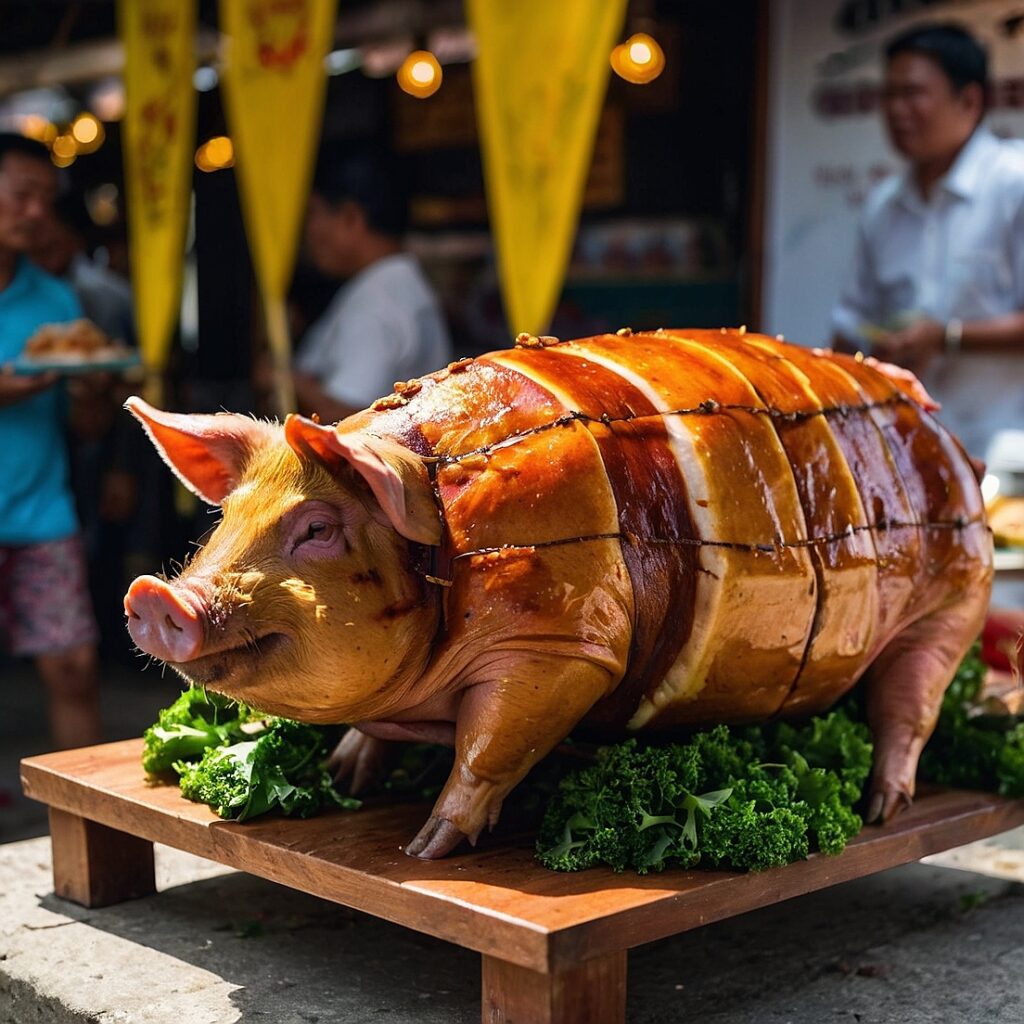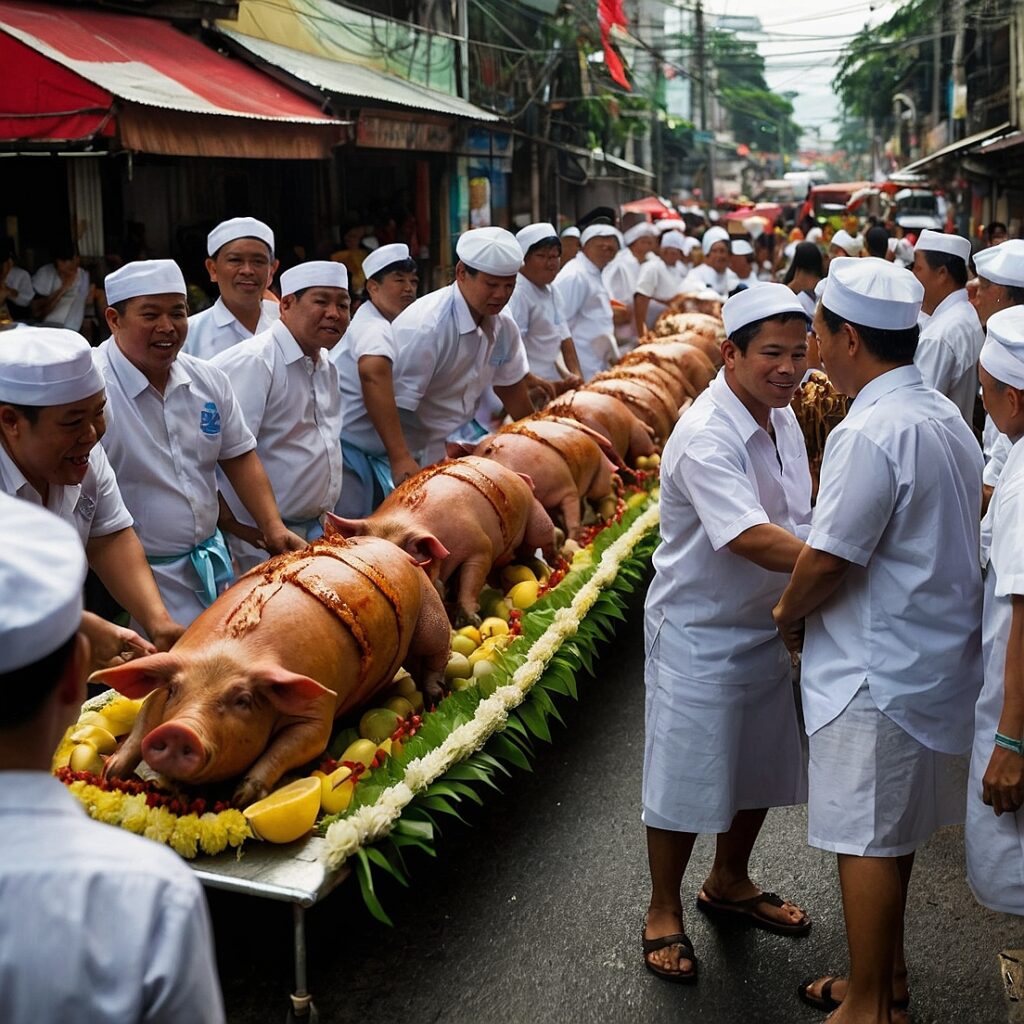Picture this: a golden-brown, crispy-skinned whole roasted pig, glistening under the sun as it’s paraded through the streets. The tantalizing aroma wafts through the air, making mouths water and stomachs growl in anticipation. This, my friends, is lechon – the undisputed star of Filipino cuisine and the centerpiece of the beloved Lechon Festival. In this blog post, we’re going to dive deep into the world of lechon, exploring its rich history, mouthwatering preparation, and the vibrant festival that celebrates this culinary masterpiece. So, grab a napkin (you might start drooling) and let’s embark on a flavorful journey through the Philippines!
The History of Lechon: From Ancient Tradition to Modern Delicacy
Origins and Cultural Significance
Lechon, which literally means “suckling pig” in Spanish, has a history as rich and complex as its flavor. The practice of roasting whole pigs can be traced back to ancient civilizations, but it was the Spanish colonizers who introduced this culinary tradition to the Philippines in the 16th century. Over time, the Filipinos embraced and adapted the dish, infusing it with local flavors and techniques to create the lechon we know and love today. Lechon quickly became more than just a meal – it transformed into a symbol of celebration, abundance, and Filipino hospitality.
Regional Variations
As lechon spread throughout the Philippine archipelago, each region put its own unique spin on the dish. From the famous Cebu lechon, known for its herb-stuffed belly and crispy skin, to the Batangas lechon with its distinctive use of oregano, every locality proudly boasts its own version of this beloved dish. These regional variations not only showcase the diversity of Filipino cuisine but also reflect the ingenuity and resourcefulness of local cooks who adapted the dish to suit their available ingredients and tastes.
Lechon in Filipino Culture
In Filipino culture, lechon is more than just food – it’s a centerpiece of social gatherings and a symbol of prosperity. No major celebration in the Philippines is complete without a lechon gracing the table. From weddings and birthdays to Christmas and New Year’s Eve, this roasted pig takes center stage, drawing families and friends together in a shared culinary experience. The act of preparing and sharing lechon has become a cherished tradition, passed down through generations and serving as a testament to the strong family bonds and community spirit that are hallmarks of Filipino culture.
The Art of Preparing Lechon: A Labor of Love
Selecting the Perfect Pig
Creating the perfect lechon begins with choosing the right pig. Typically, a young pig weighing between 25 to 40 kilograms is selected for its tender meat and optimal fat content. The pig’s age and diet play crucial roles in determining the quality of the final product. Many lechoneros (lechon makers) prefer pigs that have been fed a specific diet to enhance the flavor and texture of the meat.
Preparation and Seasoning
Once the pig is selected, the real work begins. The pig is thoroughly cleaned, and its internal organs are removed. The cavity is then stuffed with a variety of aromatic herbs and spices, which may include lemongrass, garlic, onions, and salt. Some recipes also call for stuffing the pig with herbs like oregano or tamarind leaves, while others might include fruits like star apple or breadfruit to add complexity to the flavor profile. The exact combination of stuffing ingredients often varies depending on regional preferences and family traditions.
The Roasting Process
Roasting a lechon is a time-consuming process that requires patience, skill, and constant attention. The prepared pig is skewered on a long bamboo pole and slowly roasted over hot coals for several hours. The pig is continuously turned to ensure even cooking and to achieve that perfect, crispy skin that lechon is famous for. This process can take anywhere from 4 to 6 hours, depending on the size of the pig and the desired level of doneness. Throughout the roasting process, the lechonero basts the pig with a mixture of oil, soy sauce, and other secret ingredients to enhance the flavor and help crisp up the skin.
The Final Touch: Achieving Crispy Perfection
The hallmark of a great lechon is its crackling, golden-brown skin. Achieving this requires careful temperature control and expert timing. In the final stages of roasting, the heat is often increased to create that perfect crackle. Some lechoneros even use a blowtorch to ensure every inch of the skin is crispy. The result is a masterpiece of culinary art – a whole roasted pig with skin so crisp it shatters like glass, revealing succulent, flavorful meat beneath.
The Lechon Festival: A Celebration of Filipino Culture and Cuisine
Origins and Evolution of the Festival
The Lechon Festival, also known as the “Parada ng Lechon” (Lechon Parade), is an annual event that showcases the Philippines’ love affair with this iconic dish. While various regions across the country celebrate their own versions of the festival, one of the most famous takes place in Balayan, Batangas. This particular festival originated in the 1970s as a way to honor the town’s patron saint, St. John the Baptist. Over the years, it has evolved into a grand celebration that attracts visitors from all over the Philippines and beyond.
Festival Highlights and Activities
The Lechon Festival is a feast for all the senses. The main attraction, of course, is the parade of beautifully roasted lechons through the streets of the town. These pigs are often dressed up in colorful costumes and paraded on decorated floats, creating a spectacle that’s as visually stunning as it is mouth-watering. But the festival is more than just a showcase of lechon – it’s a vibrant celebration of Filipino culture and community spirit.
Throughout the day, visitors can enjoy a wide range of activities, including:
- Cooking demonstrations showcasing different lechon preparation techniques
- Lechon-eating contests that test participants’ appetites and endurance
- Cultural performances featuring traditional Filipino music and dance
- Art exhibitions displaying works inspired by lechon and local culture
- Street games and activities for children and families
The festival culminates in a grand feast where everyone gets to sample the star of the show – the lechon. It’s a time of joy, laughter, and shared meals that epitomizes the warm hospitality and love for good food that Filipinos are known for.
The Nutritional Profile of Lechon: Indulgence with Moderation
While lechon is undoubtedly delicious, it’s important to consider its nutritional aspects. Let’s take a look at the approximate nutritional content of a typical serving of lechon (100 grams):
| Nutrient | Amount |
|---|---|
| Calories | 242 |
| Protein | 27g |
| Fat | 14g |
| Saturated Fat | 5g |
| Cholesterol | 95mg |
| Sodium | 60mg |
| Potassium | 370mg |
| Carbohydrates | 0g |
As you can see, lechon is high in protein and contains a significant amount of fat. While it can be part of a balanced diet when consumed in moderation, it’s important to be mindful of portion sizes, especially for those watching their fat and calorie intake. The crispy skin, while delicious, is particularly high in fat and should be enjoyed sparingly.
Lechon Beyond the Festival: A Year-Round Favorite
Lechon in Everyday Filipino Cuisine
While lechon takes center stage during festivals and special occasions, its influence extends far beyond these events. Many Filipino restaurants and food stalls offer lechon year-round, either as a whole roasted pig for large gatherings or in smaller portions for everyday enjoyment. Lechon has also inspired a variety of derivative dishes that allow people to enjoy its flavors more frequently.
Popular Lechon-Inspired Dishes
The popularity of lechon has given rise to several spin-off dishes that capture its essence in more accessible forms. Some of these include:
- Lechon Kawali: Crispy deep-fried pork belly that mimics the texture of lechon skin
- Paksiw na Lechon: A dish made from leftover lechon simmered in a tangy sauce
- Lechon Sisig: A sizzling dish made from chopped lechon meat and skin, typically served as a appetizer or bar snack
- Lechon Sauce: A liver-based sauce that’s often served alongside lechon and has become a condiment in its own right
These dishes allow Filipinos to enjoy the flavors of lechon more frequently, without the need for a whole roasted pig. They’ve become staples in many Filipino households and restaurants, further cementing lechon’s place in the country’s culinary landscape.
The Global Appeal of Lechon: Bringing Filipino Flavor to the World
Lechon’s International Recognition
In recent years, Filipino cuisine has been gaining recognition on the global stage, and lechon has been at the forefront of this culinary movement. International food critics and celebrity chefs have sung praises of this Filipino delicacy, helping to introduce it to a wider audience. In 2009, celebrity chef Anthony Bourdain famously declared the lechon he tasted in Cebu as “the best pig ever” on his show “No Reservations,” catapulting the dish to international fame.
Lechon in Filipino Restaurants Abroad
As Filipino communities have spread across the globe, so too has the love for lechon. Filipino restaurants in cities like New York, Los Angeles, London, and Dubai often feature lechon on their menus, introducing this beloved dish to diverse audiences. These restaurants not only cater to homesick Filipinos but also serve as ambassadors of Filipino cuisine, helping to familiarize people from other cultures with the rich flavors and traditions of the Philippines.
Adapting Lechon for International Palates
While traditionalists might argue that there’s only one way to prepare lechon, innovative chefs around the world have been experimenting with fusion versions of the dish. These adaptations often incorporate local ingredients or cooking techniques while staying true to the essence of lechon. For example, some chefs have created lechon-inspired dishes using other meats like duck or lamb, while others have incorporated lechon into non-traditional dishes like tacos or pizza. These creative interpretations help to make lechon more accessible to international diners while showcasing its versatility as a culinary concept.
The Future of Lechon: Tradition Meets Innovation
Preserving Tradition in a Changing World
As Filipino cuisine continues to evolve and gain international recognition, there’s a growing emphasis on preserving traditional cooking methods and recipes. Many lechoneros are working to pass down their skills and knowledge to younger generations, ensuring that the art of making perfect lechon isn’t lost. At the same time, culinary schools in the Philippines are incorporating lechon preparation into their curricula, recognizing its importance in Filipino gastronomy.
Sustainable Lechon: Addressing Environmental Concerns
With increasing awareness of environmental issues, some lechon producers are exploring more sustainable practices. This includes sourcing pigs from local, ethical farms, using more eco-friendly roasting methods, and finding ways to reduce waste. Some innovative chefs are even experimenting with plant-based versions of lechon, catering to the growing demand for vegetarian and vegan options while still capturing the essence of this beloved dish.
Lechon in the Digital Age
The internet and social media have played a significant role in spreading the popularity of lechon beyond the Philippines. Food bloggers, vloggers, and social media influencers regularly feature lechon in their content, sharing mouthwatering images and videos that showcase the dish’s appeal. This digital exposure has not only helped to promote lechon internationally but has also connected lechon enthusiasts around the world, fostering a global community of fans who share recipes, tips, and stories about their favorite roasted pig.
Lechon – More Than Just a Dish
As we’ve explored in this blog post, lechon is far more than just a delicious meal – it’s a cultural icon, a symbol of Filipino hospitality, and a testament to the rich culinary heritage of the Philippines. From its humble beginnings as a Spanish colonial import to its current status as the star of festivals and international culinary scenes, lechon has come a long way. It has adapted and evolved, yet remained true to its essence, much like the Filipino people themselves.
The Lechon Festival serves as a vibrant celebration of this beloved dish, bringing communities together and showcasing the best of Filipino culture. It’s a time of joy, feasting, and shared experiences that epitomize the warmth and generosity of the Filipino spirit. Whether you’re a long-time fan of lechon or someone who’s just discovering this culinary delight, there’s no denying its special place in the heart of Filipino cuisine and culture.
So, the next time you have the chance to attend a Lechon Festival or taste this crispy, succulent delight, remember that you’re not just enjoying a meal – you’re partaking in a centuries-old tradition, a celebration of community, and a testament to the enduring appeal of great food. Lechon truly is a star that shines brightly in the constellation of world cuisines, inviting us all to gather around the table and share in its delicious legacy.
Disclaimer: This blog post is based on information available up to 2021. While we strive for accuracy, culinary traditions and festival details may have changed since then. We encourage readers to verify current information and report any inaccuracies so we can correct them promptly.




